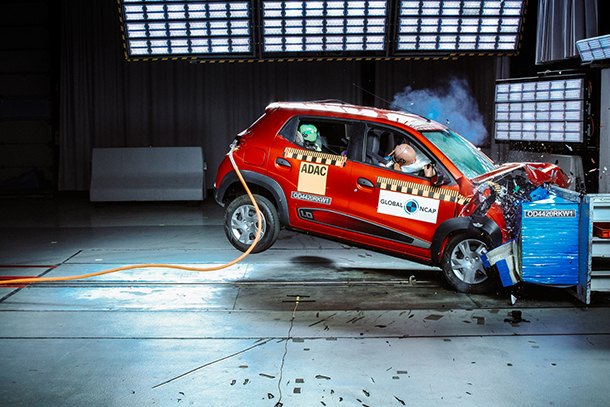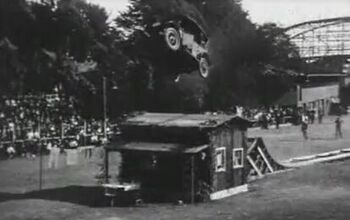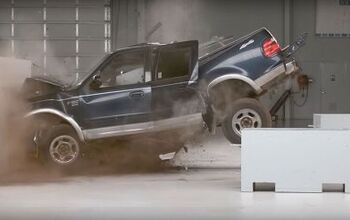South African Crash Test for Dummies
The Steed 5 pickup, Haval H1 five-door SUV, and the Renault Kwid five-door compact, all achieved poor levels of adult and child protection in crash tests conducted by Global NCAP and AA South Africa yesterday.
The Global New Car Assessment Program, or Global NCAP, inspires cooperation among new car evaluation programs, promotes the UN’s motor vehicle safety standards, and aims for a world without traffic fatalities or serious injuries. They hope to have all new cars exceeding UN crash test standards, and they also encourage the sale of more environmentally-friendly vehicles.
Most notably, the zero star-rated Steed 5 from China’s Great Wall demonstrated a high probability of life threatening injury. Alejandro Furas, Global NCAP Secretary General said, “A zero star rating causes serious concern in our crash test results. There is the potential for a life threatening injury.”
Willem Groenewald, AA South Africa CEO said, “Since the Safer Cars For Africa program originated, we’ve pleaded for safety standards improvements. We cannot have unsafe cars on our roads. We are eager to see action taken now to protect South African citizens.”
Great Wall Steed 5
Pickups are a popular African vehicle category, and Global NCAP selected the Great Wall Steed 5, which competes with the Nissan Hardbody in this segment. The Steed 5 base version without airbags was tested, and driver dummy readings indicated poor head and weak neck and chest protection, all critical body parts. As the structure and footwell area became unstable, passenger compartment deformation and steering column movement question whether an airbag would prevent serious injuries. Great Wall declined to use a Child Restraint System (CRS), and zero points were awarded for child occupant safety. The Steed 5 was without ISOFIX rear child seat anchors, or any three-point belts.
Renault Kwid
In Africa, the Kwid that was tested was manufactured in China, with two standard airbags. Protection to the driver’s head was adequate and good for the passengers. Their necks showed good protection, but the driver’s chest indicated weak protection. The unstable body and footwell structures and pedal movement are the reasons for a two-star adult occupant protection rating. With the head contacting the car’s interior and bouncing around, a lack of ISOFIX anchors, or three-point belts, the Kwid’s child occupant protection received only two stars.
Haval H1
Part of a new vehicle segment of small SUVs, the Haval H1 offers two airbags. Injuries recorded in the driver and passenger head and neck areas showed good protection, while the driver’s chest showed weak protection and the passenger’s chest was good. Feet had poor protection, and together with the driver readings, the unstable structure and footwell area explain the two-star adult occupant protection rating.
Child occupant protection was negatively affected because the manufacturer refused to use a CRS in the test, dropping dynamic points to zero. Both child dummies’ heads contacted the car during the test, threatening their safety. Lack of proper ISOFIX markings and a passenger airbag disabling switch resulted in the H1’s two-star child occupant protection rating.
Over the last 15 years, road safety has emerged as a significant global public policy issue. The and the World Bank warned that traffic injuries constitute a major public health and development crisis. The United Nations General Assembly asked the World Health Organization (WHO) to take charge of the UN Road Safety Collaboration (UNRSC). By 2030, UNRSC’s objective is to provide safe, affordable, accessible, and sustainable transportation systems, and improve road safety through the expansion of public transportation.
[Images: Global NCAP]
With a father who owned a dealership, I literally grew up in the business. After college, I worked for GM, Nissan and Mazda, writing articles for automotive enthusiast magazines as a side gig. I discovered you could make a living selling ad space at Four Wheeler magazine, before I moved on to selling TV for the National Hot Rod Association. After that, I started Roadhouse, a marketing, advertising and PR firm dedicated to the automotive, outdoor/apparel, and entertainment industries. Through the years, I continued writing, shooting, and editing. It keep things interesting.
More by Jason R. Sakurai
Latest Car Reviews
Read moreLatest Product Reviews
Read moreRecent Comments
- Lou_BC Well, I'd be impressed if this was in a ZR2. LOL
- Lou_BC This is my shocked face 😲 Hope formatting doesn't fook this up LOL
- Lou_BC Junior? Would that be a Beta Romeo?
- Lou_BC Gotta fix that formatting problem. What a pile of bullsh!t. Are longer posts costing TTAC money? FOOK
- Lou_BC 1.Honda: 6,334,825 vehicles potentially affected2.Ford: 6,152,6143.Kia America: 3,110,4474.Chrysler: 2,732,3985.General Motors: 2,021,0336.Nissan North America: 1,804,4437.Mercedes-Benz USA: 478,1738.Volkswagen Group of America: 453,7639.BMW of North America: 340,24910.Daimler Trucks North America: 261,959




































Comments
Join the conversation
The article notes no three-point belts in the Steed 5, or the Renault Kwid. So no three-point belts at all, or just three-point belts in the front? Guess I'll have to find their Web sites.
The Steed 5 specs table is confusing. It says the cheapest gas model (double cab) has no airbags, and neither does the turbo diesel - only the uplevel gas model. All have a "2-Point Seatbelt for Rear Centre Seat". But, they all have air conditioning, central locking, and an immobilizer key as standard. Oh, and a .5kg fire extinguisher, and warning triangles: https://gwm.co.za/steed5dc.html